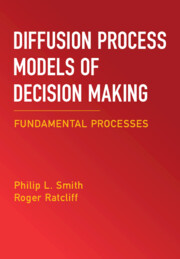Refine search
Actions for selected content:
592 results
Chapter 27 - Legal Issues in Dementia
- from Section 3 - Treatment of the Dementias
-
-
- Book:
- The Behavioral Neurology of Dementia
- Published online:
- 17 November 2025
- Print publication:
- 11 December 2025, pp 466-482
-
- Chapter
- Export citation
To ‘use or not to use’ nuclear weapons? Understanding public thinking about nuclear weapons decisions in the United States
-
- Journal:
- Judgment and Decision Making / Volume 20 / 2025
- Published online by Cambridge University Press:
- 27 October 2025, e42
-
- Article
-
- You have access
- Open access
- HTML
- Export citation

Diffusion Process Models of Decision Making
- Fundamental Processes
-
- Published online:
- 26 October 2025
- Print publication:
- 13 November 2025
Choosing portfolios of rival risky options: evidence that most people violate the no safety schools theorem
-
- Journal:
- Journal of the Economic Science Association ,
- Published online by Cambridge University Press:
- 09 October 2025, pp. 1-25
-
- Article
-
- You have access
- Open access
- HTML
- Export citation
‘No one told me I had a voice’: patient experiences of functional laryngectomy
-
- Journal:
- The Journal of Laryngology & Otology , First View
- Published online by Cambridge University Press:
- 01 October 2025, pp. 1-5
-
- Article
- Export citation
Early health technology assessment: current and future perspectives from a health technology assessment agency
-
- Journal:
- International Journal of Technology Assessment in Health Care / Volume 41 / Issue 1 / 2025
- Published online by Cambridge University Press:
- 17 September 2025, e68
-
- Article
-
- You have access
- Open access
- HTML
- Export citation
Addressing the Health Care Needs of Displaced Populations Following a Disaster: Development of Clinical Tools and Tracking Methods
-
- Journal:
- Disaster Medicine and Public Health Preparedness / Volume 19 / 2025
- Published online by Cambridge University Press:
- 04 September 2025, e248
-
- Article
- Export citation
Chapter 14 - At the Brink of a Project
- from Part III - Practical Tips
-
-
- Book:
- Cambridge Handbook of Project Behavior
- Published online:
- 22 November 2025
- Print publication:
- 28 August 2025, pp 216-232
-
- Chapter
- Export citation
A dual DfAM worksheet to assess design opportunities and restrictions in additive manufacturing
-
- Journal:
- Proceedings of the Design Society / Volume 5 / August 2025
- Published online by Cambridge University Press:
- 27 August 2025, pp. 51-60
-
- Article
-
- You have access
- Open access
- HTML
- Export citation
A knowledge framework of environment reconstruction methods for mixed reality prototype applications
-
- Journal:
- Proceedings of the Design Society / Volume 5 / August 2025
- Published online by Cambridge University Press:
- 27 August 2025, pp. 141-150
-
- Article
-
- You have access
- Open access
- HTML
- Export citation
The normative body and ‘stupid AI’: challenging compulsory able-bodiedness in human-AI interaction
-
- Journal:
- Proceedings of the Design Society / Volume 5 / August 2025
- Published online by Cambridge University Press:
- 27 August 2025, pp. 3061-3069
-
- Article
-
- You have access
- Open access
- HTML
- Export citation
Using agent-based modelling to explore the impact of social events, labour dynamics, and human factors on food production: apple harvesting as a case study
-
- Journal:
- Proceedings of the Design Society / Volume 5 / August 2025
- Published online by Cambridge University Press:
- 27 August 2025, pp. 3341-3350
-
- Article
-
- You have access
- Open access
- HTML
- Export citation
A machine learning approach towards automated classification of modal analysis results
-
- Journal:
- Proceedings of the Design Society / Volume 5 / August 2025
- Published online by Cambridge University Press:
- 27 August 2025, pp. 159-168
-
- Article
-
- You have access
- Open access
- HTML
- Export citation
Beyond 3D tic-tac-toe: from O to ball and X to boX
-
- Journal:
- Proceedings of the Design Society / Volume 5 / August 2025
- Published online by Cambridge University Press:
- 27 August 2025, pp. 721-730
-
- Article
-
- You have access
- Open access
- HTML
- Export citation
Quantitative metrics for validation and decision-making in digital twins: a comparative study on a railway braking system
-
- Journal:
- Proceedings of the Design Society / Volume 5 / August 2025
- Published online by Cambridge University Press:
- 27 August 2025, pp. 2671-2680
-
- Article
-
- You have access
- Open access
- HTML
- Export citation
A systematic literature review on emerging technology risks in Industry 4.0/5.0: identification, clustering and developing mitigation strategies
-
- Journal:
- Proceedings of the Design Society / Volume 5 / August 2025
- Published online by Cambridge University Press:
- 27 August 2025, pp. 299-308
-
- Article
-
- You have access
- Open access
- HTML
- Export citation
Can large language models support machine learning implementation in product development? A comparative analysis and perspectives
-
- Journal:
- Proceedings of the Design Society / Volume 5 / August 2025
- Published online by Cambridge University Press:
- 27 August 2025, pp. 861-870
-
- Article
-
- You have access
- Open access
- HTML
- Export citation
Flexibility evaluation of modules with a focus on interfaces
-
- Journal:
- Proceedings of the Design Society / Volume 5 / August 2025
- Published online by Cambridge University Press:
- 27 August 2025, pp. 1833-1842
-
- Article
-
- You have access
- Open access
- HTML
- Export citation
Consideration of values in design methodologies for value-driven design
-
- Journal:
- Proceedings of the Design Society / Volume 5 / August 2025
- Published online by Cambridge University Press:
- 27 August 2025, pp. 1021-1030
-
- Article
-
- You have access
- Open access
- HTML
- Export citation
An exploration into identifying assumption–making: pilot study and early insights
-
- Journal:
- Proceedings of the Design Society / Volume 5 / August 2025
- Published online by Cambridge University Press:
- 27 August 2025, pp. 519-528
-
- Article
-
- You have access
- Open access
- HTML
- Export citation
